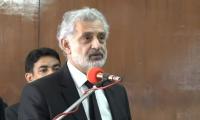ISLAMABAD: The National Electric Power Regulatory Authority (NEPRA) here on Tuesday publicised its Inquiry Committee report on the nationwide total power system collapse that occurred on January 9, 2021 at 23:40 hours, pinpointing that a bolted fault caused the blackout and pinned it to the negligence of the staff of the Guddu Power Plant.
The inquiry report also held the management of Guddu Power Plant responsible for the unusual blackout, citing their lack of supervision. It also detected that many power plants have no black start facility that led to inordinate delay in the restoration of countrywide power supply. The KE similarly lacks black start facility on its own power plants to add to the misery of its consumers.
The three-member Inquiry Committee (IC) comprising Nadir Ali Khoso, DG, NEPRA, Manu Ram, Manager (retd), and Khalid Mehmood, Chief Engineer (retd), constituted by NEPRA completed its report on February 8, 2021.
However, the regulator issued the report here on February 23, 2021 pinpointing the causes and offering solutions to avoid such ugly incidents. The IC report identified the persistent bolted fault at Guddu switchyard and resultant Unstable Power Swing in the power system as the main causes of the blackout. It recommended to “address Unstable Power Swing phenomenon,” besides undertaking a comprehensive study by a reputable international firm to avoid such incidents in future.
The committee also recommended “making black start facility available at power plants urging that a function should be developed at the powerhouse of 200MW and above to make available at least one machine ‘in island mode during under frequency situation’ to facilitate early restoration.”
It also recommended settings to be managed accordingly for sequential tripping instead of simultaneous outage of machines on over frequency. The report also highlighted a number of deficiencies in the 220kV switchyard and control room at TPS Guddu, which need to be addressed on top priority.
“The departmental inquiry against the delinquent staff and management of the Guddu Power Plant needs to be concluded. Technical trainings should be arranged for skills improvement and capacity building for staff and engineers at Guddu Power Plant. The Grid Station Equipment and Protection/Control System of 220kV Switchyard Guddu shall be maintained in accordance with SOPs issued by TSG NTDC/manufacturer of the equipment.”
It also noted lack of any centralized event recorder with NPCC (National Power Control Cell), so the sequence of tripping of transmission lines and machines in the power system cannot be ascertained precisely. It also found undesirable that “the distance relays in the system operated randomly.”
Both machines of China Power Hub and Port Qasim power stations tripped simultaneously which contributed in further aggravating the power supply. “Most of the power plants are without black start facility” except Tarbela, Mangla, Warsak and Uch Power. The black start facility at Uch Power did not work. Had the black start facility of Uch power plant been operational, it would have facilitated the restoration and curtailed the restoration time of power supply in the South Zone. It is also noticed that none of the machines went into the islanding mode during under frequency which could have also helped in early restoration of supply.
The IC also highlighted lack of contingency plans and agreed procedures between the System Operator, NTDC and power plants for restoration of supply during total and partial shutdowns. The synchronization of some of the machines of hydel power plants was within time, whereas, some units took much longer. The thermal power plants, it noted specifically, failed to start up and synchronize within the specified time. And more importantly the islanding facility available at KCCPP and BQPS-II could not be utilised and further, KE's own power plants took up to 17 hours for synchronization of all their units, which is unreasonable time for the KE being a vertically integrated utility.
According to the CTD spokesman, the two were attempting to enter Punjab from Khyber Pakhtunkhwa
Foreign Office's silence on the US threat to impose sanctions on Pakistan for economic agreements with Iran
President Zardari express views while talking to the visiting Chairman of China International Development Cooperation...
Kundi emphasised that recent electoral outcomes indicated a public preference for parliamentary cooperation over...







